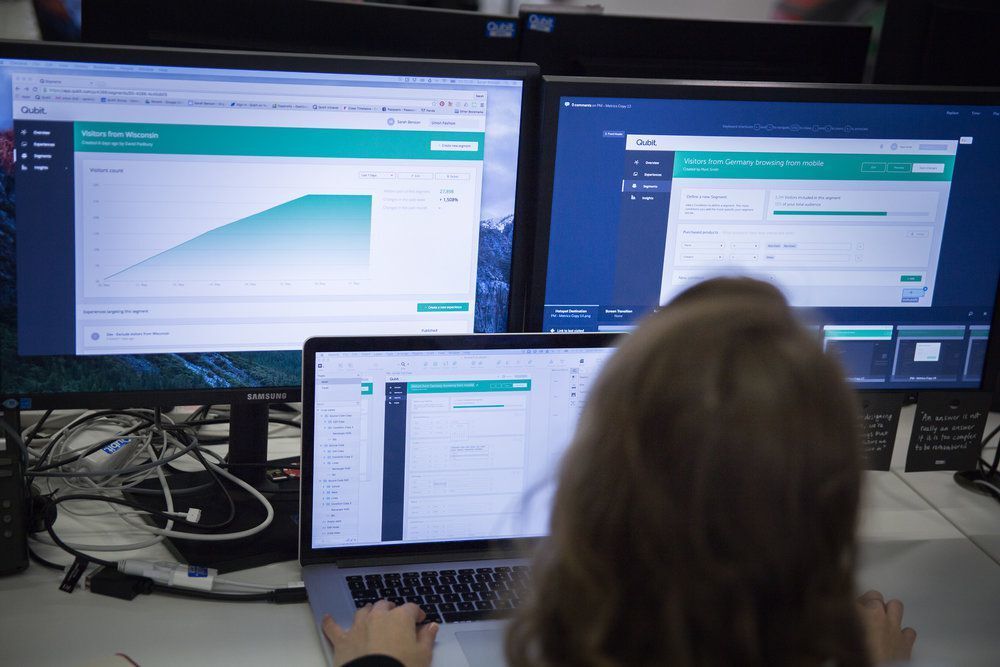
March 16, 2017
IT visionaries are shaking up the modern business world by embracing the Anywhere Worker culture and challenging long-held concepts like the 9-to-5, legacy IT hardware and fixed-location workplaces. For more IT leadership insight, check out our new book: Move Into the Modern Age : Ditch the 9-to-5.
A digital experience platform for the modern web, Qubit was founded by four ex-Googlers who understood the value of a dynamic work culture. Today, the company’s 300 employees, working in offices across the U.K., the U.S., Pakistan, France, and Germany, can connect and collaborate with each other easily thanks to their IT staff’s forward-thinking adoption of cloud-first collaboration software. We sat down with Kyle Eve (Head of IT, Qubit) to explore his perspective on the traditional 9-to-5, the work from anywhere movement and how flexibility drives productivity.
1. Do you believe the work-from-anywhere movement is changing the 9-to-5 workday?
Yes, I believe the 9-5 workday has definitely evolved over the last 25 years and it’s reflected in the way our own workplace operates. Here at Qubit’s headquarters, we have a culture where you’re free to sit and work from anywhere in the office. This really encourages people to intermingle, so different teams are constantly communicating with each other, even if they aren’t necessarily on the same projects. People gain a deeper understanding of how other teams operate, creating a stronger culture of collaboration.
To help create this type of workplace, we’re not limiting people to specific locations or specific times. If people are able to work remotely, they don’t necessarily have to stick to that 9-to-5 status quo.

2. Do you believe cloud tools like Google Workspace, Salesforce and Dialpad impact productivity and drive modern workers to change their schedules?
Because our founders came from Google, they already had an existing mindset about enabling people to choose their own best schedule for productivity. When they first founded the company in 2010, they were determined to bring that Google environment to Qubit. As a result, we have a very flexible work culture, in terms of both enabling people to work remotely and also allowing people to dictate the exact work style that’s best for them.
We’ve instilled a work-from-anywhere culture here at Qubit that resonates with our employees. A significant portion of our workforce is remote, so we use our IT infrastructure to bridge the gap between remote and local employees. By choosing the right cloud-based tools, we’re able to ensure that no matter where you are, you have the tools necessary to be productive.
Our ultimate goal is flexibility. We don’t want to chain people to legacy hardware or a restrictive environment. Instead, we’re focused on enabling people to connect and collaborate from anywhere.
3. Does enabling your employees to work from anywhere and at any time influence your it decisions? If so, how?
Our ultimate goal is flexibility. We don’t want to chain people to legacy hardware or a restrictive environment. Instead, we’re focused on enabling people to connect and collaborate from anywhere.
An example of this is our new hot-desking environment. Our employees are no longer assigned a specific office desk when they come onboard. They have the freedom to choose any desk when they come to work every day.
Our CEO was the one who first championed this initiative. The premise was simple—our entire infrastructure is cloud-based. As such, it no longer made sense to tie down employees to a specific desk or a specific mode of work.
We’re able to support this work-from-anywhere culture because of the pure-cloud IT stack we’ve built. Now, 100% of our employees are free to be productive no matter where they go.

4. What technologies do you consider essential for enabling anywhere, anytime work?
Here at Qubit, we use Google Workspace, Salesforce, and Dialpad. These tools are incredibly essential to our daily activities.
One of our most recent updates was switching to Dialpad's cloud phone system, and it’s been able to deeply integrate with Google Workspace and Salesforce. Before, when it came to legacy technology, we’d struggle with provisioning users, upgrading systems, and managing on-premise infrastructure. Now, since we’re able to connect all our essential tools in the cloud, it makes it much easier from an IT standpoint to manage and consolidate these systems.
As Kyle notes, the pure-cloud stack makes it possible for employees to collaborate on documents, update company-wide systems in real-time, and stay deeply connected no matter where they are in the world. Motivated to help their organizations reach new heights of creativity, productivity, and efficiency, IT leaders like Kyle have increasingly opted to equip their organizations with tools specifically designed to empower the modern remote workforce.




